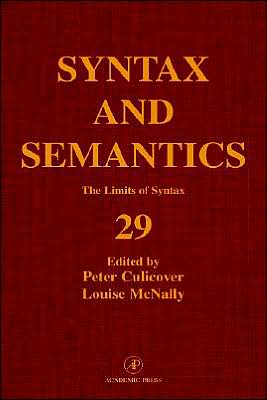The Limits of Syntax: The Limits of Syntax, Vol. 29
The Limits of Syntax is a collection of original, never before published essays. Each essay explores the ways in which greater incorporation of nonsyntactic explanations into linguistic research may deepen our understanding of problematic linguistic phenomena and, at the same time, strengthen syntactic research. To clarify the limits of syntactic explanation, these essayists investigate four areas. The first is a set of general issues related to the theory of grammar and the place of syntax...
Search in google:
The Limits of Syntax is a collection of original, never before published essays. Each essay explores the ways in which greater incorporation of nonsyntactic explanations into linguistic research may deepen our understanding of problematic linguistic phenomena and, at the same time, strengthen syntactic research. To clarify the limits of syntactic explanation, these essayists investigate four areas. The first is a set of general issues related to the theory of grammar and the place of syntax in it. The second set develops an explanation of the power of semantics pragmatics within a syntactic theory. The third addresses the status of syntactic constraints, and the fourth seeks to explain the triggering of movement in the so-called Minimalist Program and its derivational approach to syntactic representations.Key Features* Seeks to refine the theory of syntax* Encourages more adequate characterization of linguistic phenomena* Original papers form a coherent presentation Booknews A veritable Tower of Babel of contributors explore the issue of how the incorporation of nonsyntactic explanations into linguistic research over the past 35 years may deepen understanding of problematic linguistic phenomena and strengthen syntactic theory. Following an explication of the cognitive architecture of the language faculty, cross-linguistic similarities and differences are discussed in relation to: rheme and kontrast (Finnish, Hungarian, and Catalan); focus and language universals (Hungarian, English); and syntactic aspects of left dislocation (in Dutch and English). Other topics include: the linguistic encoding of information packaging instructions, strong and weak islands, and the syntax-focus structure interface. Examples are also drawn from Greek, Japanese, and Yiddish. Annotation c. by Book News, Inc., Portland, Or.
Acknowledgements. P.W. Culicover and L. McNally, On Exploring the Limits of Syntax. R. Jackendoff, The Architecutre of the Language Faculty: A Neominimalist Perspective. P.W. Culicover, The Minimalist Impulse. E. Vallduvm and M. Vilkuna, On Rheme and Konstrast. C. Roberts, Focus, the Flow of Information, and Universal Grammar. L. McNally, On the Linguistic Encoding of Information Packaging Instructions. M.R. Manzini, A Minimalist Theory of Weak Islands. N. Erteschik-Shir, The Syntax-FocusStructure Interface. R. Kluender, On the Distinction between Strong and Weak Islands: A Processing Perspective. E.F. Prince, On the Limits of Syntax, with Reference to Left- Dislocation and Topicalization. P. Jacobson, Where (If Anywhere) is Transderivationality Located? M.S. Rochemont, Phonological Focus and Structural Focus. C. J.-W. Zwart, Where is Syntax? Syntactic Aspects of Left Dislocation in Dutch and English.Index.
\ BooknewsA veritable Tower of Babel of contributors explore the issue of how the incorporation of nonsyntactic explanations into linguistic research over the past 35 years may deepen understanding of problematic linguistic phenomena and strengthen syntactic theory. Following an explication of the cognitive architecture of the language faculty, cross-linguistic similarities and differences are discussed in relation to: rheme and kontrast (Finnish, Hungarian, and Catalan); focus and language universals (Hungarian, English); and syntactic aspects of left dislocation (in Dutch and English). Other topics include: the linguistic encoding of information packaging instructions, strong and weak islands, and the syntax-focus structure interface. Examples are also drawn from Greek, Japanese, and Yiddish. Annotation c. by Book News, Inc., Portland, Or.\ \








